First and Second-Order Sorted Local Binary Pattern Features for Grayscale-Inversion and Rotation Invariant Texture Classification
Tiecheng Song,
Yuanjing Han,
Jie Feng,
Yuanlin Wang,
Chenqiang Gao

Auto-TLDR; First- and Secondorder Sorted Local Binary Pattern for texture classification under inverse grayscale changes and image rotation
Similar papers
Color Texture Description Based on Holistic and Hierarchical Order-Encoding Patterns
Tiecheng Song, Jie Feng, Yuanlin Wang, Chenqiang Gao

Auto-TLDR; Holistic and Hierarchical Order-Encoding Patterns for Color Texture Classification
Abstract Slides Poster Similar
Local Grouped Invariant Order Pattern for Grayscale-Inversion and Rotation Invariant Texture Classification
Yankai Huang, Tiecheng Song, Shuang Li, Yuanjing Han
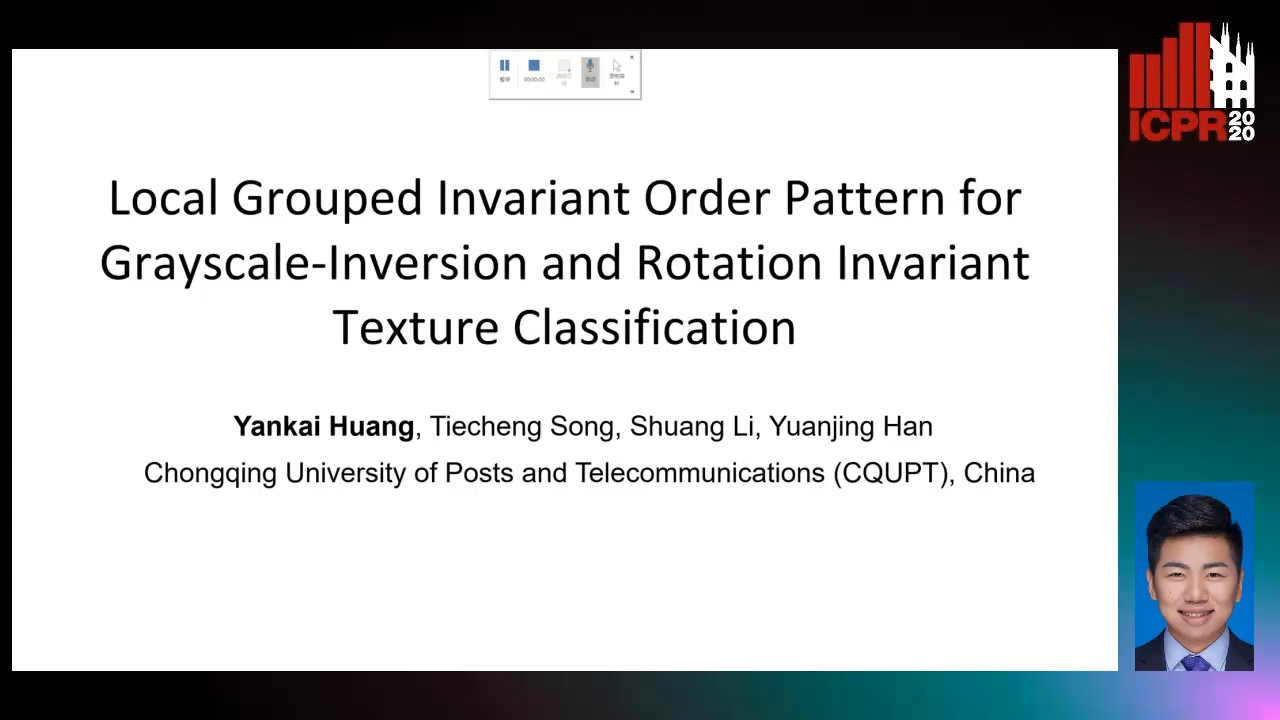
Auto-TLDR; Local grouped invariant order pattern for grayscale-inversion and rotation invariant texture classification
Abstract Slides Poster Similar
Local Binary Quaternion Rotation Pattern for Colour Texture Retrieval
Hela Jebali, Noel Richard, Mohamed Naouai
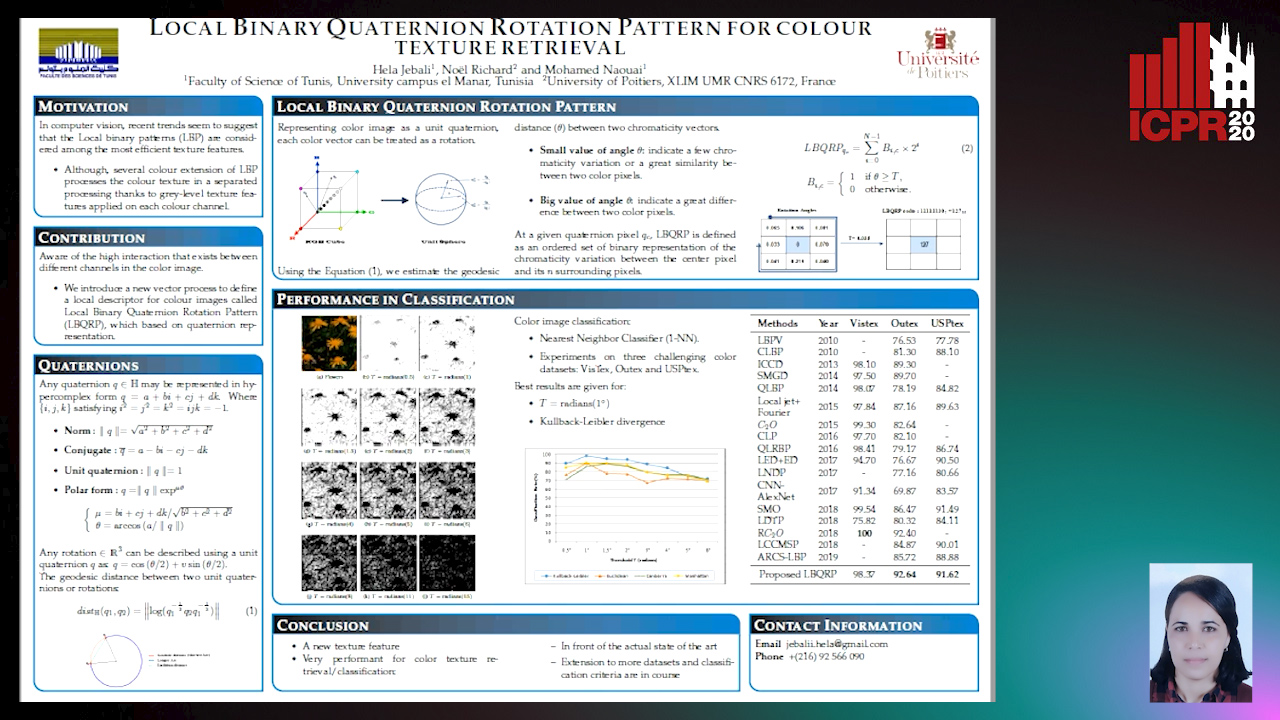
Auto-TLDR; Local Binary Quaternion Rotation Pattern for Color Texture Classification
Gaussian Convolution Angles: Invariant Vein and Texture Descriptors for Butterfly Species Identification
Xin Chen, Bin Wang, Yongsheng Gao

Auto-TLDR; Gaussian convolution angle for butterfly species classification
Abstract Slides Poster Similar
Face Anti-Spoofing Based on Dynamic Color Texture Analysis Using Local Directional Number Pattern
Junwei Zhou, Ke Shu, Peng Liu, Jianwen Xiang, Shengwu Xiong
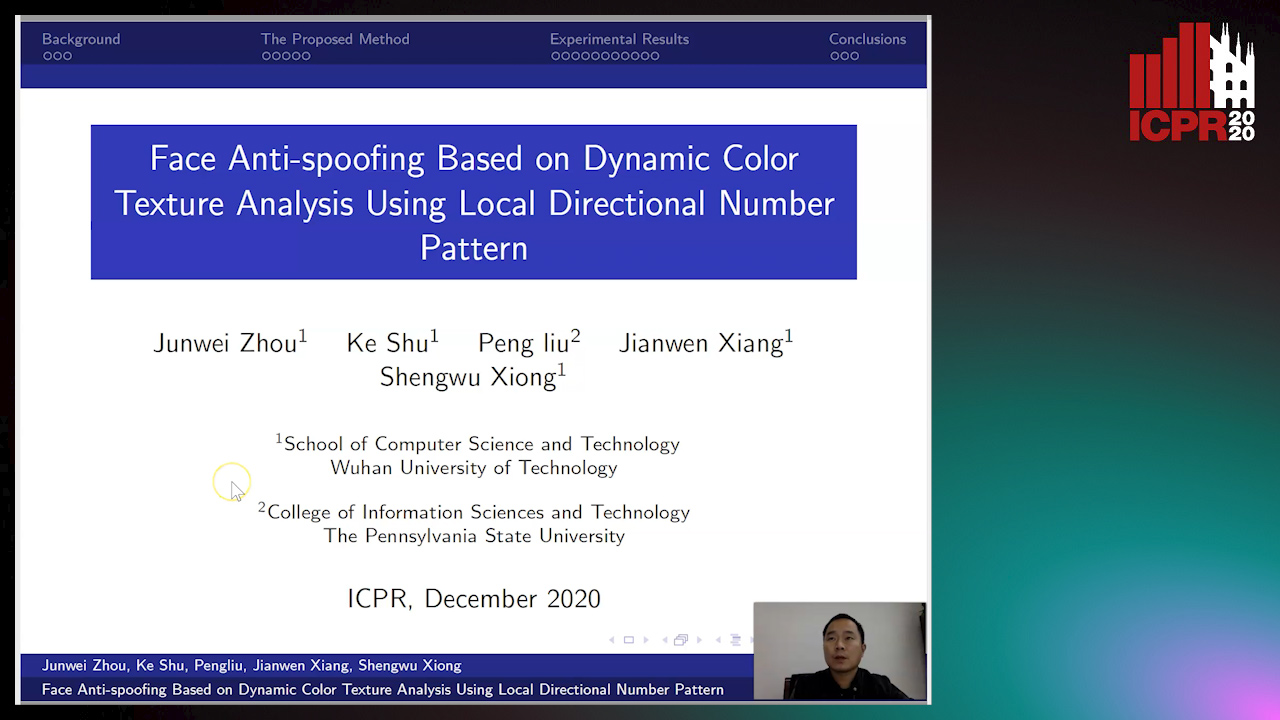
Auto-TLDR; LDN-TOP Representation followed by ProCRC Classification for Face Anti-Spoofing
Abstract Slides Poster Similar
Joint Learning Multiple Curvature Descriptor for 3D Palmprint Recognition
Lunke Fei, Bob Zhang, Jie Wen, Chunwei Tian, Peng Liu, Shuping Zhao
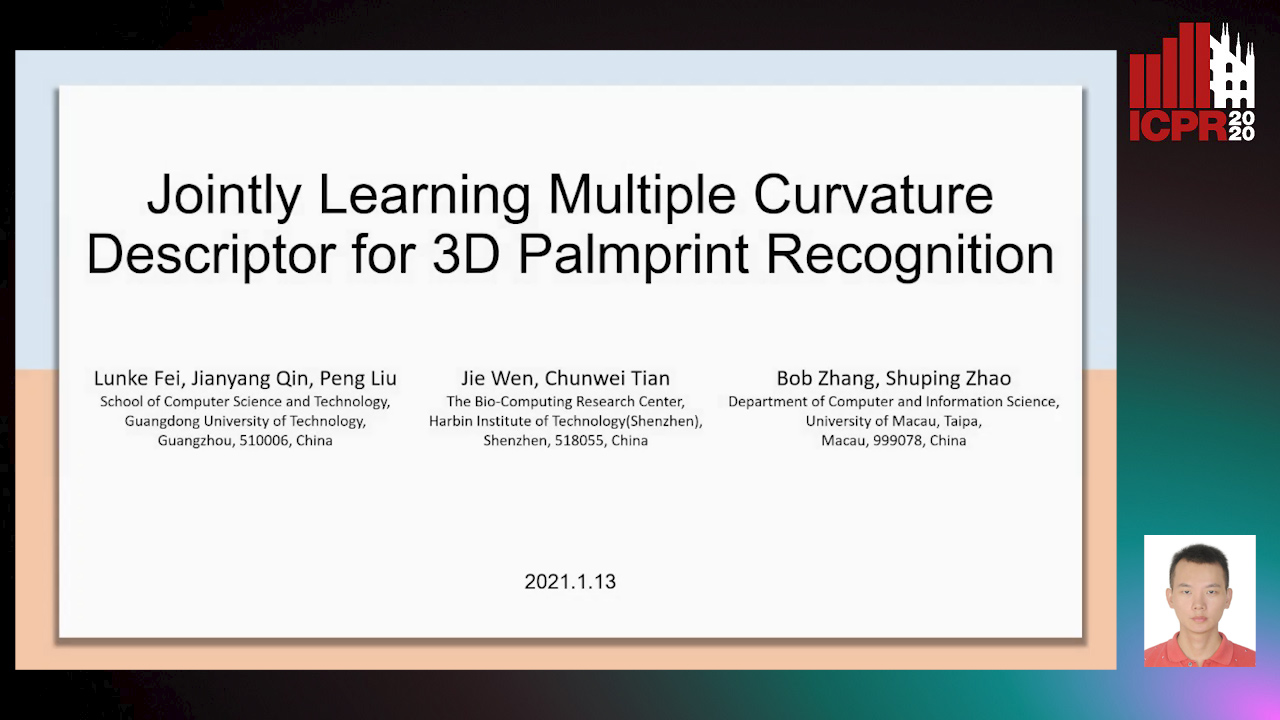
Auto-TLDR; Joint Feature Learning for 3D palmprint recognition using curvature data vectors
Abstract Slides Poster Similar
Appliance Identification Using a Histogram Post-Processing of 2D Local Binary Patterns for Smart Grid Applications
Yassine Himeur, Abdullah Alsalemi, Faycal Bensaali, Abbes Amira

Auto-TLDR; LBP-BEVM based Local Binary Patterns for Appliances Identification in the Smart Grid
Automatic Tuberculosis Detection Using Chest X-Ray Analysis with Position Enhanced Structural Information
Hermann Jepdjio Nkouanga, Szilard Vajda

Auto-TLDR; Automatic Chest X-ray Screening for Tuberculosis in Rural Population using Localized Region on Interest
Abstract Slides Poster Similar
A Local Descriptor with Physiological Characteristic for Finger Vein Recognition
Liping Zhang, Weijun Li, Ning Xin

Auto-TLDR; Finger vein-specific local feature descriptors based physiological characteristic of finger vein patterns
Abstract Slides Poster Similar
Object Classification of Remote Sensing Images Based on Optimized Projection Supervised Discrete Hashing
Qianqian Zhang, Yazhou Liu, Quansen Sun
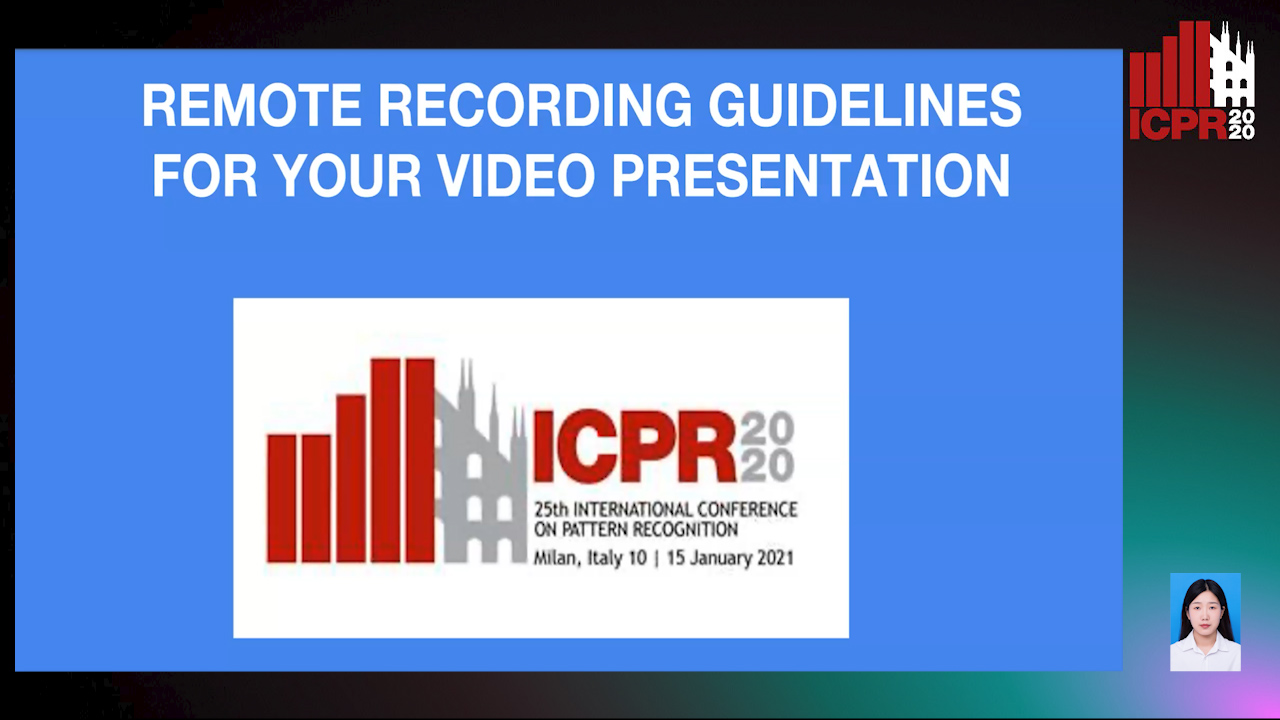
Auto-TLDR; Optimized Projection Supervised Discrete Hashing for Large-Scale Remote Sensing Image Object Classification
Abstract Slides Poster Similar
Feature Extraction by Joint Robust Discriminant Analysis and Inter-Class Sparsity
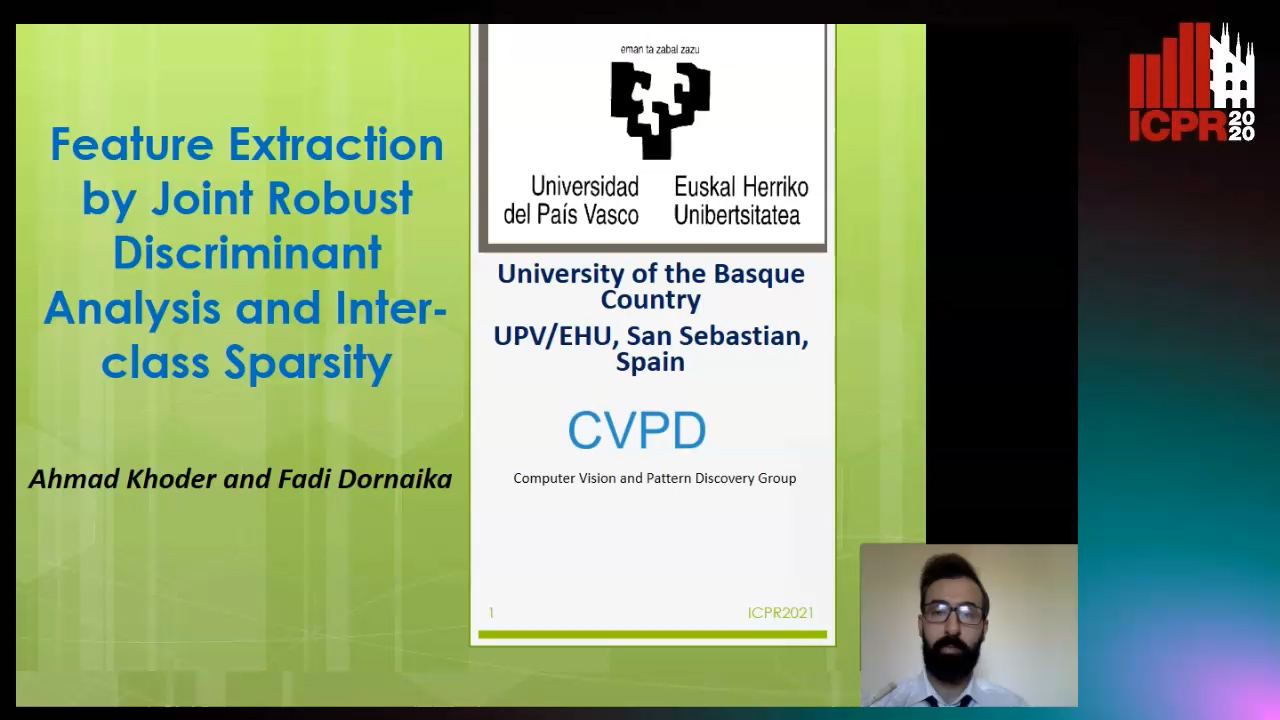
Auto-TLDR; Robust Discriminant Analysis with Feature Selection and Inter-class Sparsity (RDA_FSIS)
Merged 1D-2D Deep Convolutional Neural Networks for Nerve Detection in Ultrasound Images
Mohammad Alkhatib, Adel Hafiane, Pierre Vieyres

Auto-TLDR; A Deep Neural Network for Deep Neural Networks to Detect Median Nerve in Ultrasound-Guided Regional Anesthesia
Abstract Slides Poster Similar
Magnifying Spontaneous Facial Micro Expressions for Improved Recognition
Pratikshya Sharma, Sonya Coleman, Pratheepan Yogarajah, Laurence Taggart, Pradeepa Samarasinghe

Auto-TLDR; Eulerian Video Magnification for Micro Expression Recognition
Abstract Slides Poster Similar
Electroencephalography Signal Processing Based on Textural Features for Monitoring the Driver’s State by a Brain-Computer Interface
Giulia Orrù, Marco Micheletto, Fabio Terranova, Gian Luca Marcialis
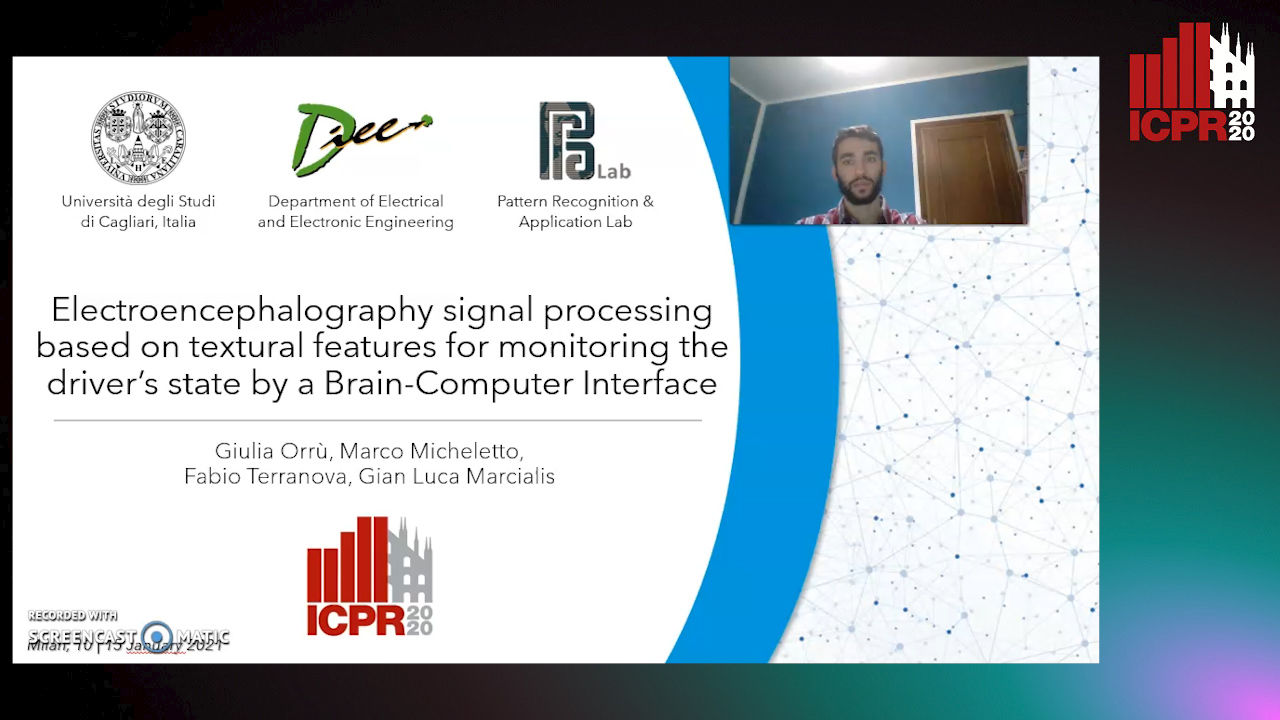
Auto-TLDR; One-dimensional Local Binary Pattern Algorithm for Estimating Driver Vigilance in a Brain-Computer Interface System
Abstract Slides Poster Similar
A Distinct Discriminant Canonical Correlation Analysis Network Based Deep Information Quality Representation for Image Classification
Lei Gao, Zheng Guo, Ling Guan Ling Guan

Auto-TLDR; DDCCANet: Deep Information Quality Representation for Image Classification
Abstract Slides Poster Similar
Label Self-Adaption Hashing for Image Retrieval
Jianglin Lu, Zhihui Lai, Hailing Wang, Jie Zhou
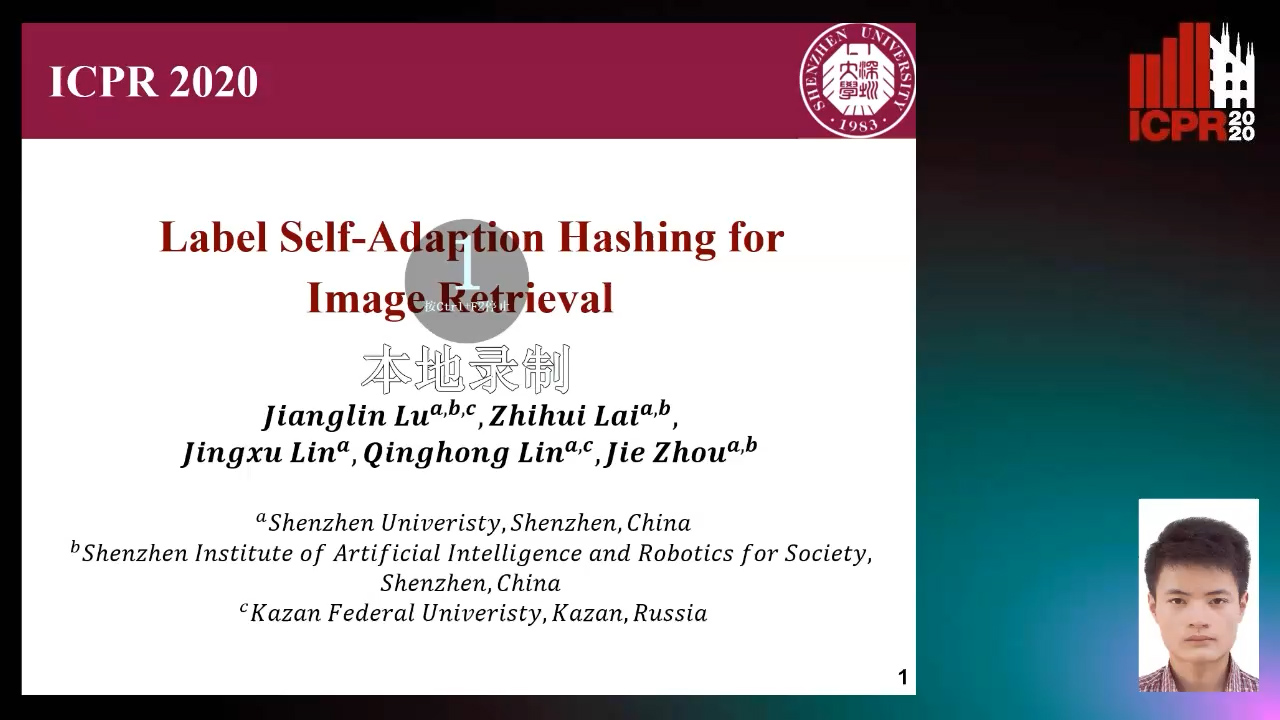
Auto-TLDR; Label Self-Adaption Hashing for Large-Scale Image Retrieval
Abstract Slides Poster Similar
Multi-Scale Keypoint Matching

Auto-TLDR; Multi-Scale Keypoint Matching Using Multi-Scale Information
Abstract Slides Poster Similar
Face Anti-Spoofing Using Spatial Pyramid Pooling
Lei Shi, Zhuo Zhou, Zhenhua Guo

Auto-TLDR; Spatial Pyramid Pooling for Face Anti-Spoofing
Abstract Slides Poster Similar
A Multi-Focus Image Fusion Method Based on Fractal Dimension and Guided Filtering
Nikoo Dehghani, Ehsanollah Kabir

Auto-TLDR; Fractal Dimension-based Multi-focus Image Fusion with Guide Filtering
Abstract Slides Poster Similar
DSPNet: Deep Learning-Enabled Blind Reduction of Speckle Noise
Yuxu Lu, Meifang Yang, Liu Wen

Auto-TLDR; Deep Blind DeSPeckling Network for Imaging Applications
Attention-Based Deep Metric Learning for Near-Duplicate Video Retrieval
Kuan-Hsun Wang, Chia Chun Cheng, Yi-Ling Chen, Yale Song, Shang-Hong Lai

Auto-TLDR; Attention-based Deep Metric Learning for Near-duplicate Video Retrieval
Video Lightening with Dedicated CNN Architecture
Li-Wen Wang, Wan-Chi Siu, Zhi-Song Liu, Chu-Tak Li, P. K. Daniel Lun
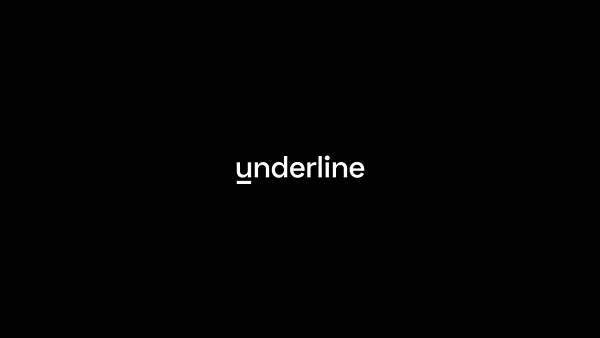
Auto-TLDR; VLN: Video Lightening Network for Driving Assistant Systems in Dark Environment
Abstract Slides Poster Similar
Documents Counterfeit Detection through a Deep Learning Approach
Darwin Danilo Saire Pilco, Salvatore Tabbone
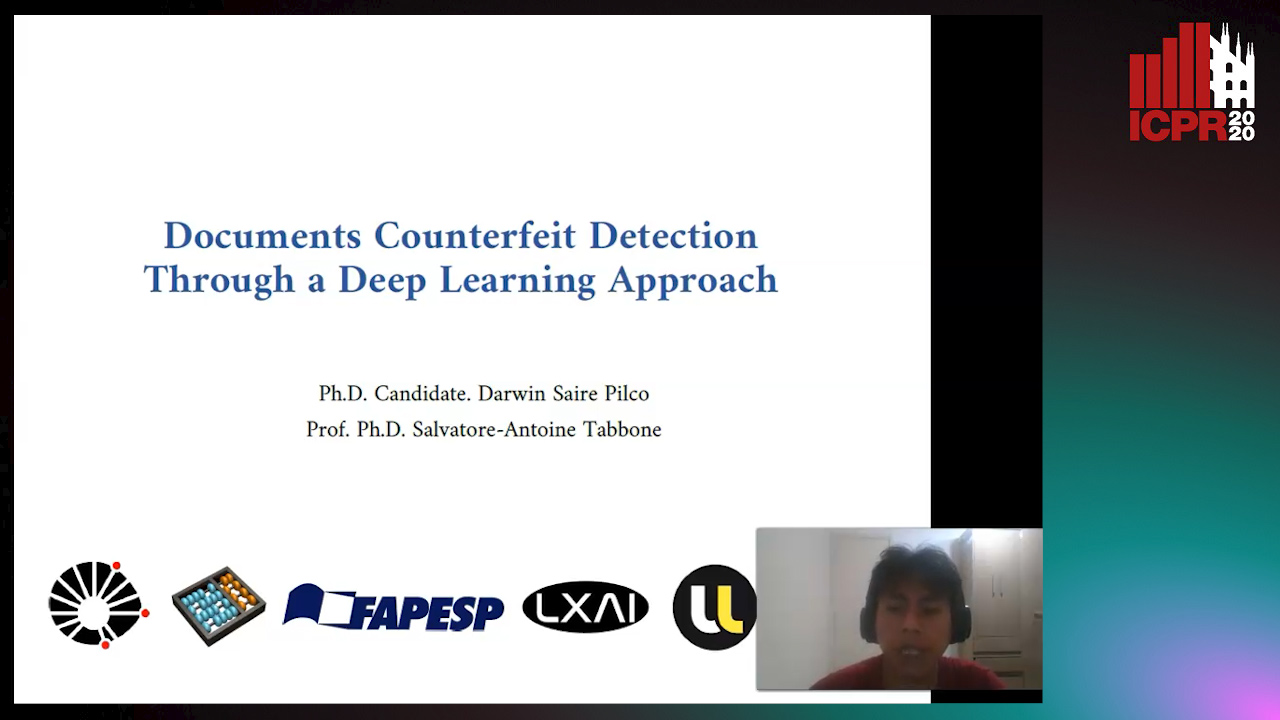
Auto-TLDR; End-to-End Learning for Counterfeit Documents Detection using Deep Neural Network
Abstract Slides Poster Similar
Embedding Shared Low-Rank and Feature Correlation for Multi-View Data Analysis
Zhan Wang, Lizhi Wang, Hua Huang

Auto-TLDR; embedding shared low-rank and feature correlation for multi-view data analysis
Abstract Slides Poster Similar
Unsupervised Feature Learning for Event Data: Direct vs Inverse Problem Formulation
Dimche Kostadinov, Davide Scarammuza

Auto-TLDR; Unsupervised Representation Learning from Local Event Data for Pattern Recognition
Abstract Slides Poster Similar
Creating Classifier Ensembles through Meta-Heuristic Algorithms for Aerial Scene Classification
Álvaro Roberto Ferreira Jr., Gustavo Gustavo Henrique De Rosa, Joao Paulo Papa, Gustavo Carneiro, Fabio Augusto Faria
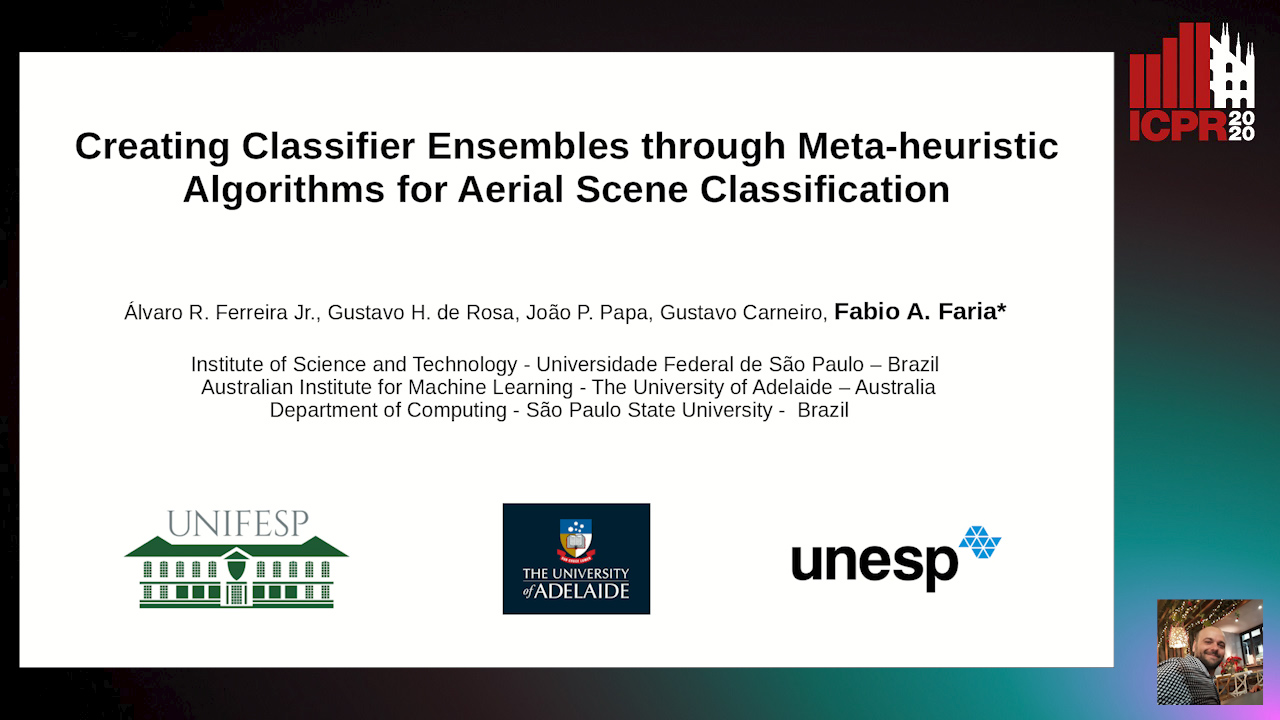
Auto-TLDR; Univariate Marginal Distribution Algorithm for Aerial Scene Classification Using Meta-Heuristic Optimization
Abstract Slides Poster Similar
Improving Image Matching with Varied Illumination

Auto-TLDR; Optimizing Feature Matching for Stereo Image Pairs by Stereo Illumination
Abstract Slides Poster Similar
Photometric Stereo with Twin-Fisheye Cameras
Jordan Caracotte, Fabio Morbidi, El Mustapha Mouaddib
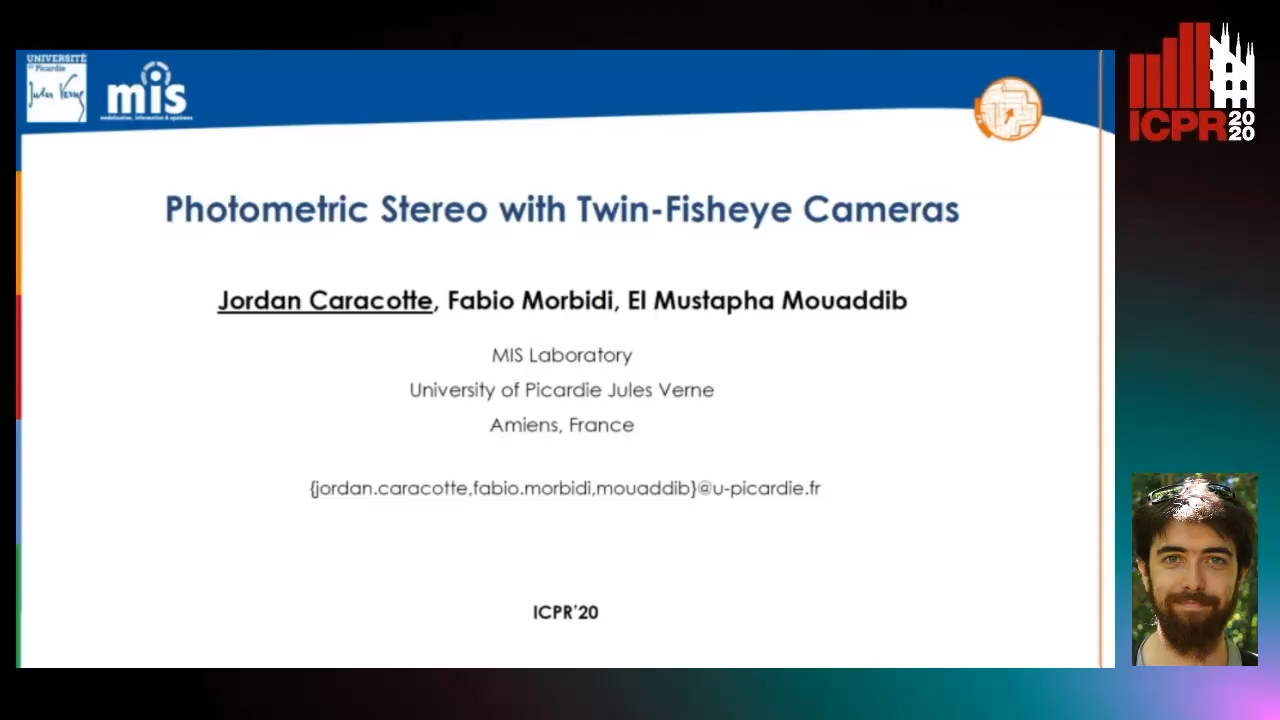
Auto-TLDR; Photometric stereo problem for low-cost 360-degree cameras
Abstract Slides Poster Similar
Supervised Feature Embedding for Classification by Learning Rank-Based Neighborhoods
Ghazaal Sheikhi, Hakan Altincay

Auto-TLDR; Supervised Feature Embedding with Representation Learning of Rank-based Neighborhoods
Visual Saliency Oriented Vehicle Scale Estimation
Qixin Chen, Tie Liu, Jiali Ding, Zejian Yuan, Yuanyuan Shang

Auto-TLDR; Regularized Intensity Matching for Vehicle Scale Estimation with salient object detection
Abstract Slides Poster Similar
Convolutional Feature Transfer via Camera-Specific Discriminative Pooling for Person Re-Identification
Tetsu Matsukawa, Einoshin Suzuki

Auto-TLDR; A small-scale CNN feature transfer method for person re-identification
Abstract Slides Poster Similar
Rotation Invariant Aerial Image Retrieval with Group Convolutional Metric Learning
Hyunseung Chung, Woo-Jeoung Nam, Seong-Whan Lee

Auto-TLDR; Robust Remote Sensing Image Retrieval Using Group Convolution with Attention Mechanism and Metric Learning
Abstract Slides Poster Similar
PointSpherical: Deep Shape Context for Point Cloud Learning in Spherical Coordinates
Hua Lin, Bin Fan, Yongcheng Liu, Yirong Yang, Zheng Pan, Jianbo Shi, Chunhong Pan, Huiwen Xie

Auto-TLDR; Spherical Hierarchical Modeling of 3D Point Cloud
Abstract Slides Poster Similar
Aggregating Object Features Based on Attention Weights for Fine-Grained Image Retrieval
Hongli Lin, Yongqi Song, Zixuan Zeng, Weisheng Wang

Auto-TLDR; DSAW: Unsupervised Dual-selection for Fine-Grained Image Retrieval
Local Attention and Global Representation Collaborating for Fine-Grained Classification
He Zhang, Yunming Bai, Hui Zhang, Jing Liu, Xingguang Li, Zhaofeng He

Auto-TLDR; Weighted Region Network for Cosmetic Contact Lenses Detection
Abstract Slides Poster Similar
DFH-GAN: A Deep Face Hashing with Generative Adversarial Network
Bo Xiao, Lanxiang Zhou, Yifei Wang, Qiangfang Xu

Auto-TLDR; Deep Face Hashing with GAN for Face Image Retrieval
Abstract Slides Poster Similar
Feature Extraction and Selection Via Robust Discriminant Analysis and Class Sparsity

Auto-TLDR; Hybrid Linear Discriminant Embedding for supervised multi-class classification
Abstract Slides Poster Similar
Learning Recurrent High-Order Statistics for Skeleton-Based Hand Gesture Recognition
Xuan Son Nguyen, Luc Brun, Olivier Lezoray, Sébastien Bougleux
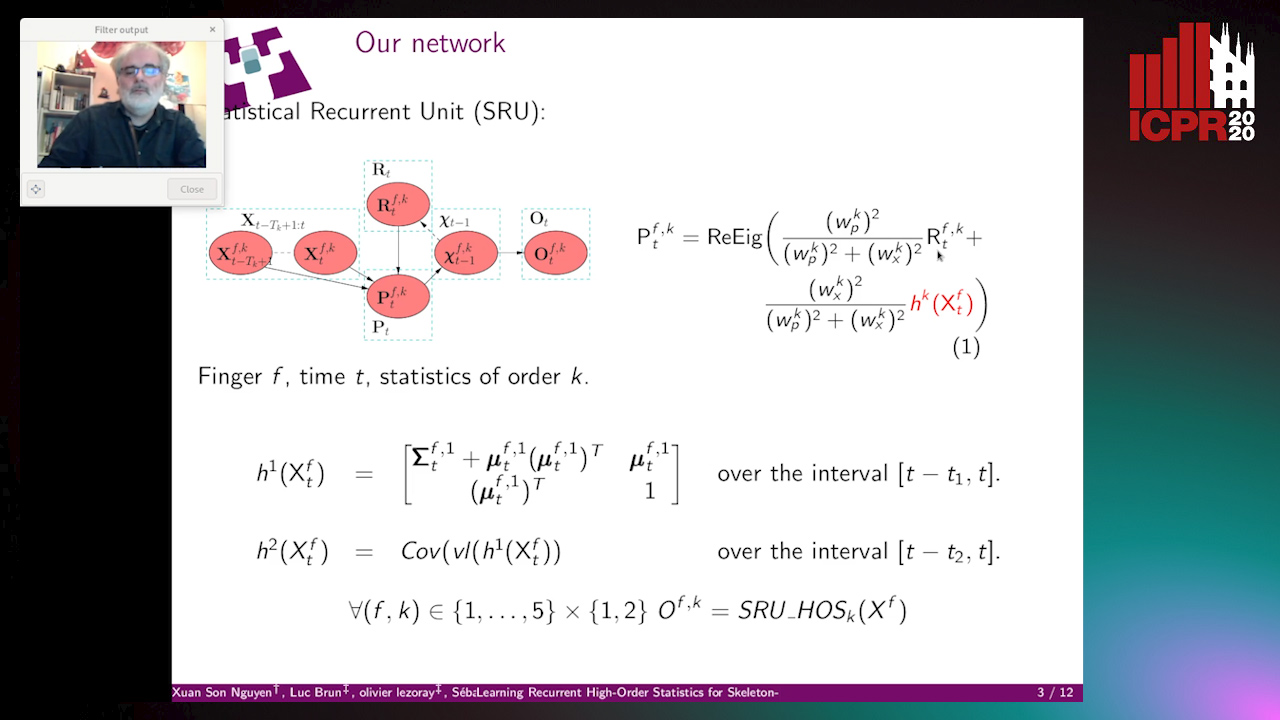
Auto-TLDR; Exploiting High-Order Statistics in Recurrent Neural Networks for Hand Gesture Recog-nition
MixNet for Generalized Face Presentation Attack Detection
Nilay Sanghvi, Sushant Singh, Akshay Agarwal, Mayank Vatsa, Richa Singh

Auto-TLDR; MixNet: A Deep Learning-based Network for Detection of Presentation Attacks in Cross-Database and Unseen Setting
Abstract Slides Poster Similar
Modeling Extent-Of-Texture Information for Ground Terrain Recognition
Shuvozit Ghose, Pinaki Nath Chowdhury, Partha Pratim Roy, Umapada Pal
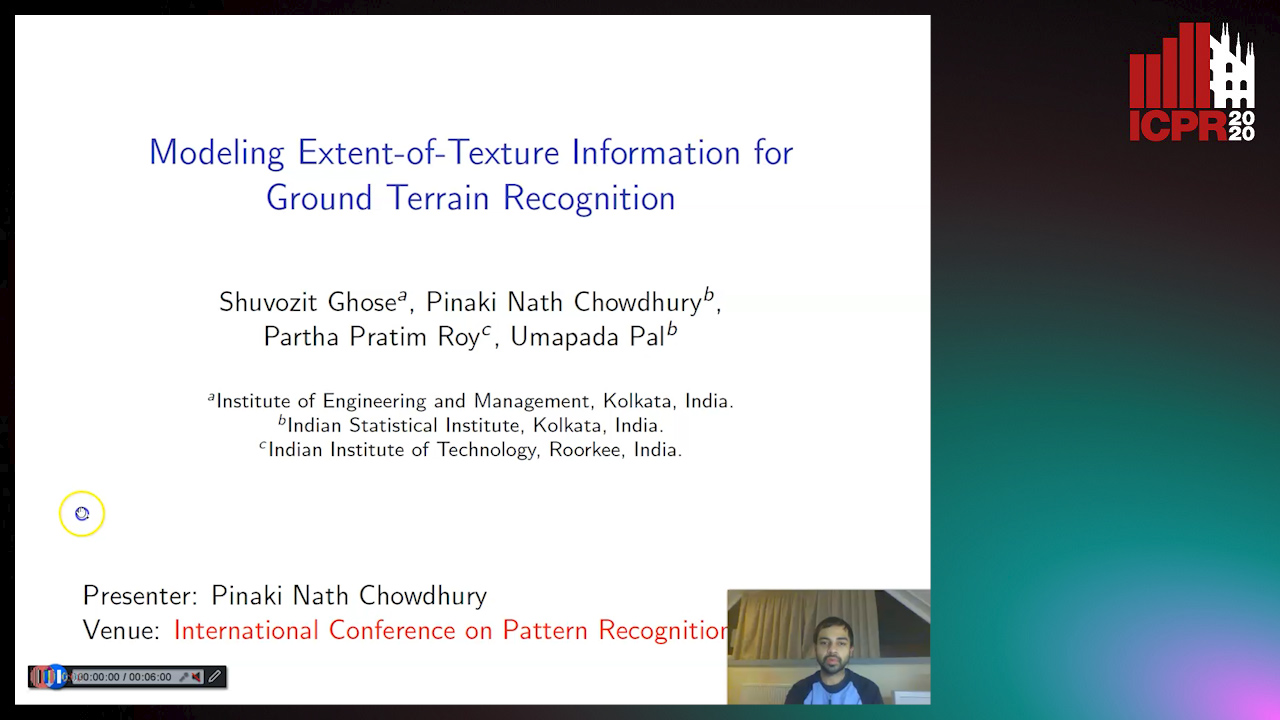
Auto-TLDR; Extent-of-Texture Guided Inter-domain Message Passing for Ground Terrain Recognition
Abstract Slides Poster Similar
Discrete Semantic Matrix Factorization Hashing for Cross-Modal Retrieval
Jianyang Qin, Lunke Fei, Shaohua Teng, Wei Zhang, Genping Zhao, Haoliang Yuan

Auto-TLDR; Discrete Semantic Matrix Factorization Hashing for Cross-Modal Retrieval
Abstract Slides Poster Similar
3D Facial Matching by Spiral Convolutional Metric Learning and a Biometric Fusion-Net of Demographic Properties
Soha Sadat Mahdi, Nele Nauwelaers, Philip Joris, Giorgos Bouritsas, Imperial London, Sergiy Bokhnyak, Susan Walsh, Mark Shriver, Michael Bronstein, Peter Claes

Auto-TLDR; Multi-biometric Fusion for Biometric Verification using 3D Facial Mesures
Quality-Based Representation for Unconstrained Face Recognition
Nelson Méndez-Llanes, Katy Castillo-Rosado, Heydi Mendez-Vazquez, Massimo Tistarelli

Auto-TLDR; activation map for face recognition in unconstrained environments
SynDHN: Multi-Object Fish Tracker Trained on Synthetic Underwater Videos
Mygel Andrei Martija, Prospero Naval

Auto-TLDR; Underwater Multi-Object Tracking in the Wild with Deep Hungarian Network
Abstract Slides Poster Similar
Understanding When Spatial Transformer Networks Do Not Support Invariance, and What to Do about It
Lukas Finnveden, Ylva Jansson, Tony Lindeberg
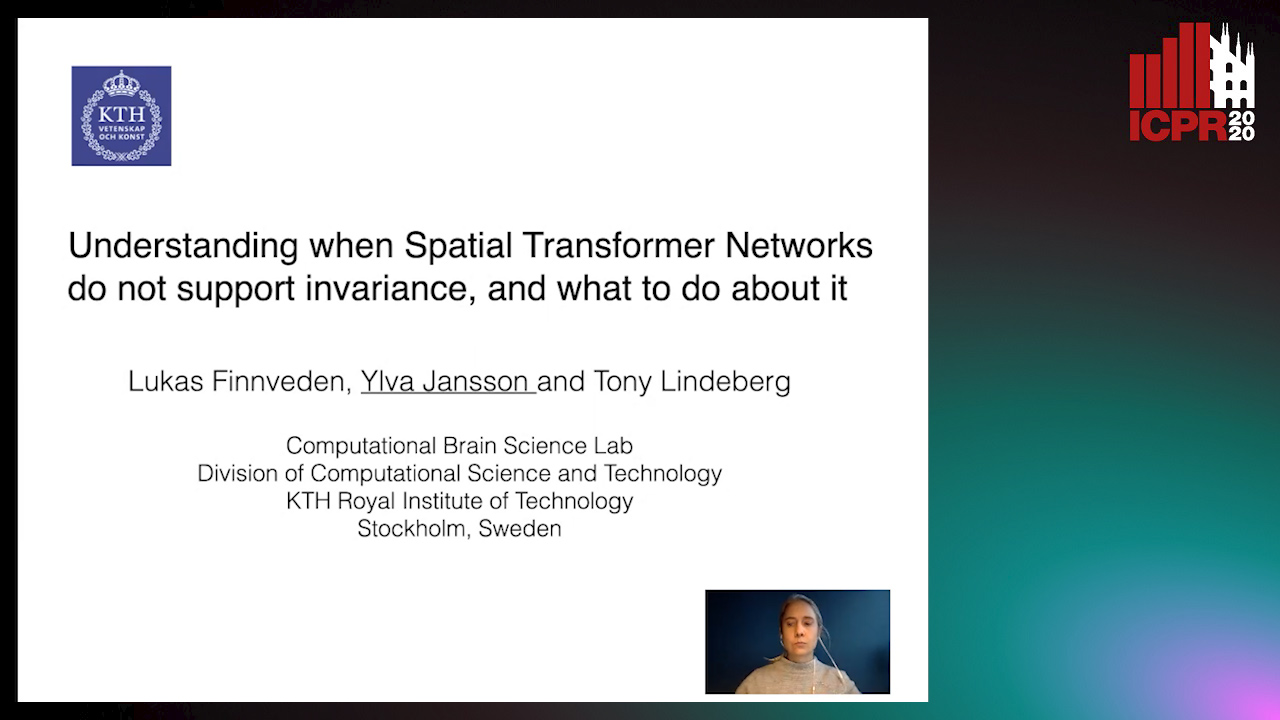
Auto-TLDR; Spatial Transformer Networks are unable to support invariance when transforming CNN feature maps
Abstract Slides Poster Similar
Adaptive Context-Aware Discriminative Correlation Filters for Robust Visual Object Tracking
Tianyang Xu, Zhenhua Feng, Xiaojun Wu, Josef Kittler

Auto-TLDR; ACA-DCF: Adaptive Context-Aware Discriminative Correlation Filter with complementary attention mechanisms
Abstract Slides Poster Similar
Unconstrained Vision Guided UAV Based Safe Helicopter Landing
Arindam Sikdar, Abhimanyu Sahu, Debajit Sen, Rohit Mahajan, Ananda Chowdhury

Auto-TLDR; Autonomous Helicopter Landing in Hazardous Environments from Unmanned Aerial Images Using Constrained Graph Clustering
Abstract Slides Poster Similar
Second-Order Attention Guided Convolutional Activations for Visual Recognition
Shannan Chen, Qian Wang, Qiule Sun, Bin Liu, Jianxin Zhang, Qiang Zhang
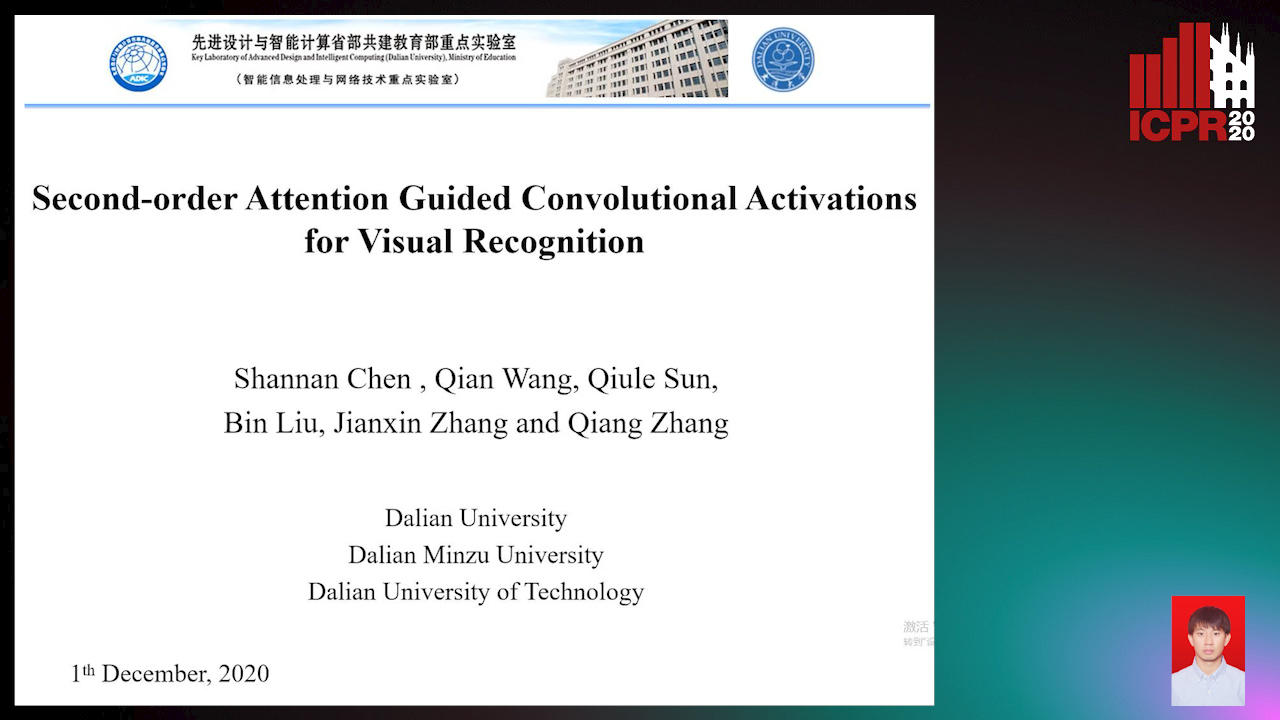
Auto-TLDR; Second-order Attention Guided Network for Convolutional Neural Networks for Visual Recognition
Abstract Slides Poster Similar